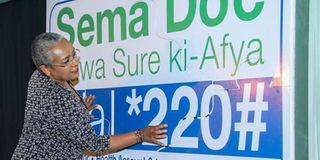Cuban doctors good, telemedicine better

Sema Doc which was launched by First Lady Mrs Margaret Kenyatta on August 11, 2015 is just an example of how telemedicine works. PHOTO | FILE / PSCU
What you need to know:
- Telemedicine embraces a variety of practical applications including transmitting images such as radiographs.
- This practice saves a patient’s time and cost: doctors often charge less for a telemedicine consultation than they do for an in-person visit.
- Further, telemedicine can help patients who want a second opinion, as well as doctors who want to consult with experts on complicated cases.
In a bid to plug the current health professionals gap, the government has imported a short-term solution in the name of doctors from Cuba. Whereas these health professionals may be a boon to underserved counties, which have perennially suffered inadequate health personnel, in the grand scheme of things, this is only a drop in the bucket.
By bringing into Kenya health professionals from another country, the government is acknowledging that on our own we are unable to offer the necessary health services to our country and that we need a helping hand from abroad.
BEST PRACTICE
But here is one limitation: even though the doctors from Cuba may be highly qualified, they will not be able to perform miracles if they do not have the necessary tools to diagnose and treat. They may know what they need to do, but like their Kenyan counterparts, they will be hampered by the lack of equipment or when available, the equipment maybe ineffective.
Where health is concerned, the best practice nowadays is not to bring foreign health professionals, but to use technology and consult with them from their home country, through the use of technology, or telemedicine.
REMOTE SURGERY
Telemedicine is the remote diagnosis and treatment of patients enhanced by technology. Doctors use technology to evaluate, diagnose, and treat patients all without their physical presence in the doctor’s office. The medical experts maybe in the country or continents away.
The right hardware such as computers, cameras and medical devices as well as software, and telecommunication services make it possible to connect patients to specialists regardless of the distance between them.
Telemedicine embraces a variety of practical applications including transmitting images such as radiographs, advising patients over the telephone using computer-based protocols, or more comprehensive activities such as remote surgical procedures and consultations. Technology allows a faraway specialist to evaluate a patient’s MRI, X-ray, or other scans and tests.
LESS CHARGES
With telemedicine, for example, you or your doctor can send a digital image of a suspicious rash, along with your medical history, to a dermatologist, who will review it, diagnose and prescribe medication to treat it.
This practice saves a patient’s time and cost: doctors often charge less for a telemedicine consultation than they do for an in-person visit. Further, telemedicine can help patients who want a second opinion, as well as doctors who want to consult with experts on complicated cases.
Going by the number of patients who travel to India, South Africa and other countries seeking treatment, there is a clear demand for telemedicine in Kenya.
The writer is an informatics specialist. E-mail: [email protected] @samwambugu2





